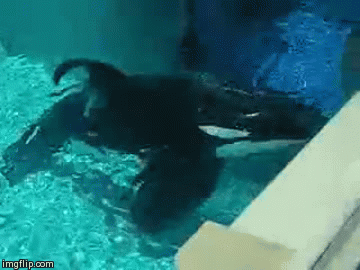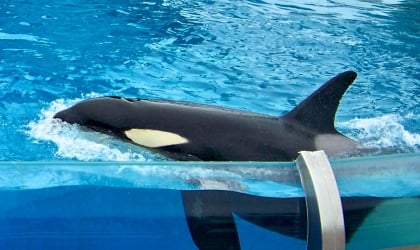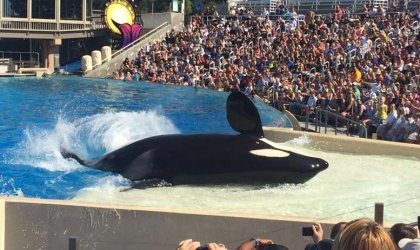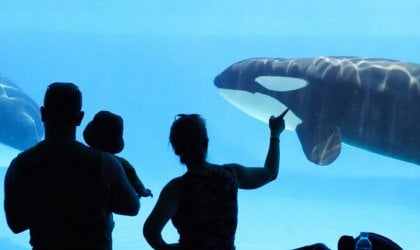1. Orcas Get Sunburned
Orcas at SeaWorld spend most of their time floating listlessly on the surface of the water with little to no shade from the hot, blistering sun. In nature, orcas spend up to 95% of their time submerged and would find shade in the depths of the ocean. But at SeaWorld, their tanks are far too shallow—about 34 feet deep—not nearly deep enough to give them a reprieve from the harsh sun. Because of this, orcas have perpetual sunburns, which former trainers have reported were shielded from the public eye with black zinc oxide, which matches their skin. Although zinc oxide was also used as sunblock, orcas were almost always sunburned before it was applied.
2. Some Orcas Were Kidnapped and Sent to SeaWorld
Three orcas currently at SeaWorld were kidnapped from their ocean homes, as were others who have since died. For example, Corky, the oldest and longest-held captive orca in the world, was captured off the coast of British Columbia in 1969. She wasn’t taken from her natural environment because she was injured. Instead, she was torn away from her family against her will and confined to small concrete tanks for a hefty profit.
 © Terrell C. Newby, Ph.D.
© Terrell C. Newby, Ph.D.3. Killed if Not Captured
In 1965, SeaWorld’s first-ever orca show was performed by a female orca named Shamu at SeaWorld San Diego. During Shamu’s capture, her mother was shot with a harpoon and killed in full view of the young orca by a marine “cowboy” named Edward “Ted” Griffin. His partner, Don Goldsberry, later worked for SeaWorld and was assigned to bring orcas into the park. He continued to kidnap and slaughter orcas, and at one point, he hired divers to cut open the bodies of four orcas, fill them with rocks, put anchors around their tails, and sink them to the bottom of the ocean so that their deaths wouldn’t be discovered.
 © Terrell C. Newby, Ph.D.
© Terrell C. Newby, Ph.D.4. Trainers Masturbate Dolphins and Whales to Collect Sperm
In nature, dolphins choose their own mates. But at SeaWorld, they’re forced to breed on a regular basis. Male bottlenose dolphins are masturbated, and females are torn out of the water and sometimes drugged so that they can’t fight back while staff shove tubes filled with semen into their uteruses. Some animals, like Ariel, endure this process repeatedly—only to produce more animals who will spend their lives in deprivation.
5. Unsafe Conditions for SeaWorld’s Trainers
SeaWorld’s corporate incident log contains reports of more than 100 incidents of orca aggression at its parks, often resulting in injuries to humans and even death. In 2010, SeaWorld trainer Dawn Brancheau sustained multiple traumatic injuries and drowned during an incident involving Tilikum the orca. In front of horrified visitors, Tilikum ripped off her left arm and part of her scalp, crushed her ribs, and broke bones throughout her body before drowning her.
Even though trainers are no longer allowed in the water with orcas, there have still been reported injuries. In 2022, an orca bit a trainer’s arm at SeaWorld Orlando in Florida, causing several fractures to her forearm and wrist that required surgery.
6. Orcas in Marine Parks Have Shorter Life Expectancies
In the wild, orcas live an average of 30 to 50 years and their estimated maximum life expectancy is 60 to 70 years for males and 80 to 90 for females. The more than 40 orcas who have died at SeaWorld reached an average age of only 14.

7. Collapsed Dorsal Fins Aren’t Normal or Healthy
In captivity, all adult male orcas have collapsed dorsal fins, which is a sign that an animal is injured or unhealthy. SeaWorld claims that this condition is natural. However, collapsed dorsal fins are a symptom of the unnatural environment of marine parks and are rarely seen in the wild.
8. Trainers Are Performers, Not Biologists
Contrary to popular belief, trainers often have no formal education in marine biology. Their main purpose is to entertain visitors, not to educate them about the intelligent, highly social animals held at SeaWorld or how they spend their lives with their families and forage freely in their natural habitat.

9. SeaWorld Sells a Fantasy About Conservation
In 2021, SeaWorld contributed only about 0.1% of its profits to its conservation fund. Any gestures the company may have made to help animals are far outweighed by the egregious daily suffering and the staggering number of deaths they endure at its parks.
Real conservation efforts focus fully on supporting and protecting animals in their natural habitat. If SeaWorld had a real commitment to conservation, it wouldn’t imprison animals in tanks for human entertainment.
10. Animals Suffer in Cramped, Unnatural Living Conditions
SeaWorld confines whales and dolphins to tanks that, to them, are the size of a bathtub. Orcas can swim up to 150 miles a day and bottlenose dolphins up to 60, but at SeaWorld, they can only swim in endless circles.
*****
SeaWorld presents itself as a family establishment full of fun “educational” activities. However, these activities harm animals physically and emotionally. SeaWorld has the financial means and ability to create coastal sanctuaries, where the orcas, other dolphins, and whales it confines could lead a more natural life and have the opportunity to feel ocean currents, see and sense other marine animals, and engage in natural behavior. However, SeaWorld instead chooses to stick with the same inhumane business model that it has used for 60 years, despite all the violent and deadly incidents that have occurred and other evidence of harm. Please say NO to SeaWorld and its enslavement of animals by refusing to buy a ticket to this abusement park and ask it to release these animals to seaside sanctuaries.
Learn more about cruelty at SeaWorld on The PETA Podcast:
Listen to more episodes on iTunes, Stitcher, and Spotify! Subscribe for new episodes.





